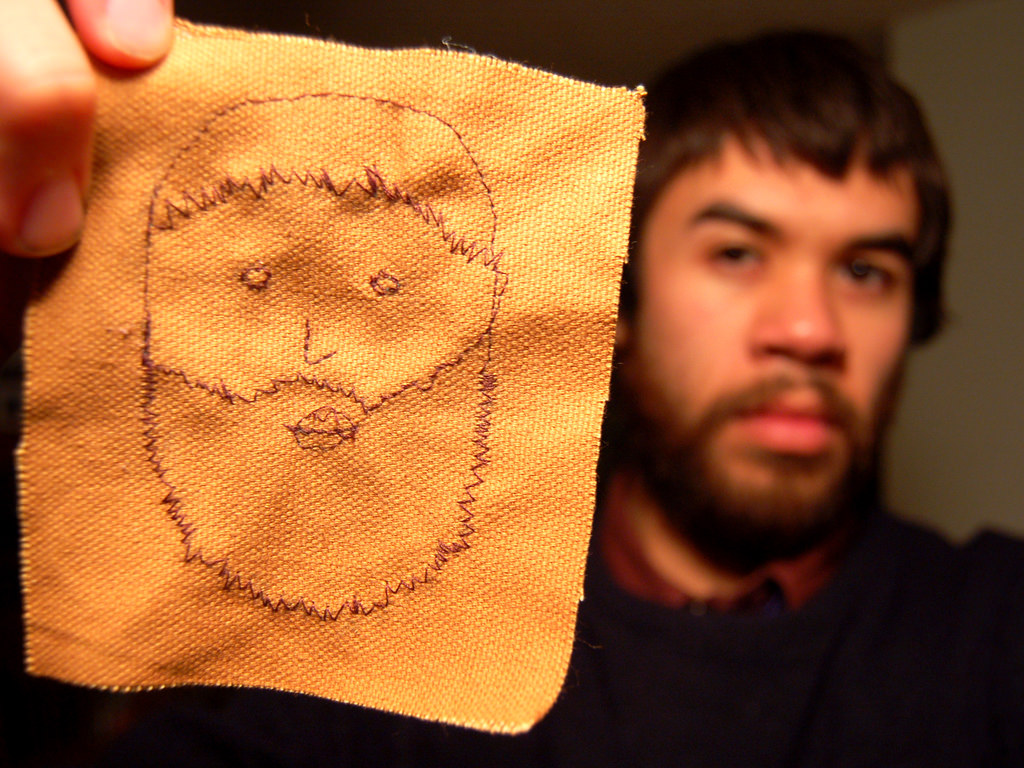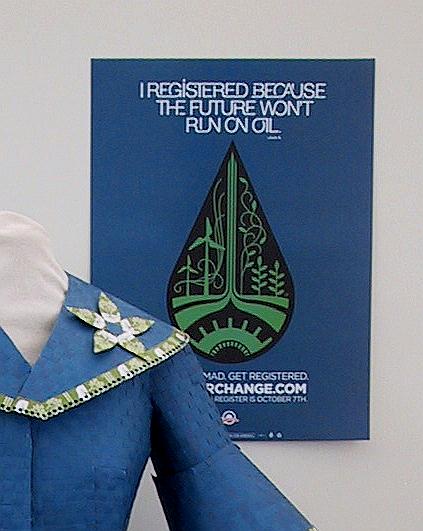Recycle Runway Blog
Put-on your Principals, Wear your Values, Slip into your Standards

My Label Dress, Photo Harry Glazier
In this fifth and final post of this series I give some ideas about what YOU CAN DO to reduce the environmental and social impacts of the clothing you wear.
To recap my series, the first blog post, explained how through preparing new work for ECO FASHION WEEK, I took a deep dive into the environmental and social impacts of our clothing. The second post explored the world of fast fashion. My third post used the journey of a simple T-Shirt to see how the clothing industry is the second most polluting industry in the world after oil. The forth blog post shared my experience creating the ECO FASHION WEEK collection/performance piece that led to this blog series.
AN EASY 5 POINT PLAN TO GREEN YOUR WARDROBE
1. STOP buying new clothes!
I know this may seem kind of radical and maybe very difficult, but do you really NEED that new shirt or pair of shoes? If you count how many pieces of clothing you currently have in your closet and drawers, you will see that you could live for a long time without adding anything new to your wardrobe. Americans purchase an average of one new piece of clothing a week 1. If you fit into this average category but my solution feels farfetched, then at least try to reduce how much you buy. Here are some ways to do this:
- Wait a week before making any new purchase
- Clothing moratorium – try not buying new clothes for 1 or 2 weeks, or even 3 months
- Avoid the sale racks – most sale racks are designed to convince us to purchase something we don’t need
- Set a monthly spending limit – pick a low number and stick to it
When you do purchase new clothing try to:
- Support sustainable practices (for example organic cotton) and fair trade organizations. Check out these resources for environmental and ethical clothing:
– Project Just
– The Fashion Transparency Index 2016 [PDF]
– Remake
– KnowTheChain.org
– FairTradeUSA.org
– GoodGuide.com
- Buy durable and well made items that you know will last and avoid fast fashion
- Support local and small scale designers whose designs are locally made, meaning less environmental impact from shipping items halfway around the world to hang in your closet. Many small-scale designers are more ethical in their choices about fabrics, manufacturing, and worker’s rights. However, it is a good thing to investigate before assuming…
2. Repair what you already own
The idea of darning a sock feels as antiquated as the horse and buggy, but across the globe the art of repairing our clothing and other possessions is making a comeback. Fix-It-Fairs take place throughout the Portland area where I live. You can bring all kinds of items to these community events and citizens with sewing machines, tool kits and the “know-how” will fix your stuff.

Photo: Ace Armstrong
If you don’t have a fix-it-fair in your area or want to learn to “do-it-yourself”, check out www.ifixit.com. This is a wiki-based site that teaches people how to fix almost anything. Anyone can create a repair manual for a device, and anyone can also edit the existing set of manuals to improve them. The site empowers individuals to share their technical knowledge with the rest of the world. They even have a clothing page https://www.ifixit.com/Device/Clothing that teaches you basics like sewing a button or mending a rip, to more complicated tasks like repairing a zipper.
REPAIR has been added to the “Reduce, Reuse, Recycle” phrase as an important way of reducing our waste. Additionally, I really appreciate the act of repairing because it respects the resources that went into creating that item.
Plus, repairing items can add character to your clothing! An interesting patch or, visible mending, can liven up a boring pair of pants, a shirt, or a coat!
3. Purchase second-hand clothes or go to clothing swaps

Stylist Jason Pillay, photo Harry Glazier
Have you noticed how many more thrift and consignment stores there are compared to just 15 years ago? According the Association of Resale Professionals the number of resale shops increases 7% every year.2 They attribute this to people being more interested in recycling/reuse, which could be true, and because people love shopping and getting bargains, which for good or bad we know is true. But I also think it has to do with the glut of clothing (and other STUFF) in our world because of fast fashion. Whatever the reason, purchasing gently used clothing instead of buying new clothes is very impactful in terms of reducing your carbon footprint!
And if you have never been to a clothing swap, they are an amazingly fun, and economical, way of getting rid of clothes you don’t wear anymore and picking up new items you need. My closet has many clothing swap scores!
Remember though to always give your unwanted clothing to thrift/consignment stores or take them to clothing swaps. In my first blog in this series I mentioned that the average American throws away 81lbs of clothes every year and the clothing recycling market is only capturing 15% of that, the rest goes into the landfill! Even ripped and torn clothing and fabric can be used for industrial rags and building insulation.
4. Caring for your clothing
I was surprised to learn that up to 80% of our clothing’s impact during its lifecycle comes while we wear them. This is because it takes a lot of energy to heat the water for washing and a lot energy to keep the dryer running. So there’s a huge opportunity to decrease your environmental footprint, by simply greening your laundry habits. The following list, borrowed from an article in TreeHugger, shows fabulous ways to do this:
- Wash your clothes only when needed
The Levi Strauss CEO Chip Bergh actually promotes NEVER washing your jeans! That might be a bit radical for most, but we can all wash our clothes far less than we do. Except for the obvious items that need washing after one wear, I use the sniff test on shirts and visually inspect my clothes to determine if they need to be washed yet. Washing clothing after one wear is definitely unnecessary in most cases and degrades the colors and the fabric! - Use green laundry detergent
Conventional detergents can contain ingredients that aren’t good for you, your clothes, or aquatic ecosystems where the dirty water we wash down the drain can end up. Phosphates in conventional laundry soaps can cause algal blooms that negatively affect ecosystems and marine life. To shop for more eco-friendly detergents, look for labels that indicate a product is readily biodegradable and phosphate-free, and made from plant- and vegetable-based ingredients (instead of petroleum-based), which means they’re healthier for the planet, from production to rinse cycle. - Wash in cold water
A whopping 90 percent of energy used for washing clothes goes to heating the water, costing you $100 or more every year. With more and more detergents specialized for cold-water washing, your whites will still get white without the hot (or warm) water. Next, be sure to wash only full loads of laundry, which ensures that your machine is operating at peak efficiency. If you can’t manage to fill ‘er up, the “load size selector option” (if you have one) ensures that smaller loads use less water. - Hang it out to dry

Designer Henry Wanjala, photo Nicole Morris
There are upward of 88 million dryers in the U.S., each emitting more than a ton of carbon dioxide per year. Because dryers uses so much energy, skipping it altogether can make a real difference. While some homeowners’ associations and municipalities oppose hanging clothes out to dry, the pro-line drying movement, headed up by Right to Dry, is putting up a good defense for your right to harvest free solar energy. Added bonus? Clothes last longer when you line dry because there’s less wear and tear than when you use the dryer.
- Maximize your dryer
Line-drying doesn’t have to be an all or nothing choice. If you’re sticking with the dryer for part (or all) of the time, cleaning the lint filter frequently will increase efficiency and shorten drying time. If your dryer has a moisture sensor, use it. This will automatically reduce the amount of drying time or shut off the machine when it senses that clothes are dry, which reduces wear and tear on your threads and saves lots of energy. A good moisture sensor is the best thing to look for if you’re shopping for a new clothes dryer. As of this year, Energy Star began to rate dryers, so make sure to check for their stamp of approval.
TreeHugger also recomends ditching the dryer sheets, which can be full of cancer-causing chemicals and neurotoxins such as toluene and styrene. They also break down organic fibers, shortening the life of your fabrics. Instead, toss a sachet of dried organic lavender in the dryer for a healthy, sweet scent. - Don’t iron if you don’t have to
Not only is ironing a tedious chore, it also consumes energy and can deteriorates fabric. Still, no self-respecting environmentalist wants to look ruffled, right? To avoid looking haggard, simply hang clothes up immediately after the wash cycle is complete. The water still in them will work with gravity to pull most wrinkles out. For wrinkle-prone clothing such as linen, cut the final spin cycle, which will leave even more water in the garments, creating yet more pull. Then fold dry clothes where you want creases to be, and place them under other clothes in your dresser, which will further help to press them. - Don’t bother with dry cleaning
Conventional dry cleaning is a decidedly un-green process; most businesses use the chemical perchloroethylene (also called “perc”), which research studies have shown may be dangerous to our health. Exposure to this chemical has been linked to increased risks of bladder, esophageal, and cervical cancer; eye, nose, throat and skin irritation; and reduced fertility; among other effects. Yikes!
Luckily, there are alternatives. For starters, if you want to eliminate dry cleaning from your life, start by buying clothes that don’t require it–it’s wise to read labels before making purchases. Also, recognize that many delicates and other garments, including those made from cashmere and lambs’ wool, can be safely and easily hand washed. 3

Stylist Jerome Insorio, photo Domnic Arenas
5. Reclaim fashion as a form of personal creativity!
Lastly let me just say that I hate to be manipulated and the fashion industry, by definition, is all about dictating what we should and should not wear any given year. They guide our purchasing decisions to benefit their bottom line— not to benefit the consumer, the workers, or the planet and that MAKES ME MAD!
If you enjoy fashion, then I encourage you to create your own sense of style. Though I don’t go clothing shopping very often anymore, when I do I love shopping at thrift stores, I find that it encourages creative dressing. You can discover interesting items and combine them in unusual ways that reflect your personality and lifestyle! I have included photos throughout this blog post from other ECO FASHION WEEK stylists and designers that exemplify creative fashion play at its best.
We have come to the end of this long look at the impacts of the clothing that we wear. And as you probably realize, many of these same facts hold true for most items in our lives, not just our clothing. From basketballs to frying pans, most of the things we buy are made outside of the country by people working in unfair conditions that we would NEVER accept for ourselves or our family. And they are made from mined and manufactured materials that are harmful to the planet, that use a lot of energy to make, fuel to transport and that pollute the air, water and soil in the process. Reducing our consumption, and reusing EVERYTHING in our life is essential!
I would love to hear what was most useful in this series to you, and how you might change your actions based upon what you have read here or elsewhere. You can respond below or send me a private message at Nancy@RecycleRunway.com. And thanks for taking this journey with me!
1Cline, Elizabeth L. Overdressed: The Shockingly High Cost of Cheap Fashion. Reprint edition. Portfolio, 2013. Print.
2 NARTS. “Industry Statistics & Trends.” Professional Trade Association. NARTS: The Association of Resale Professionals. N.p., 2017. Web. 9 Feb. 2017. http://www.narts.org/i4a/pages/index.cfm?pageid=3285
3 TreeHugger. “11 Ways to Green your Laundry.” Environmental. Team Treehugger HTGG. N.p., 10 July, 2014. Web. 9 Feb. 2017. http://www.treehugger.com/htgg/how-to-go-green-laundry.html
This series was co-researched and co-written with Nicole Morris.








































